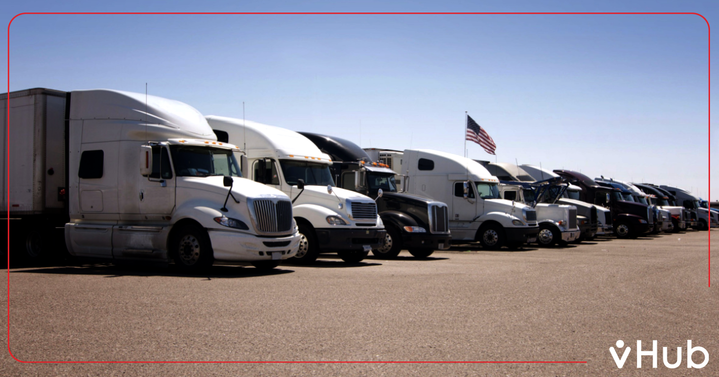Shippers are constantly trying to trim down their transportation costs. Due to continued supply chain disruptions caused by the global pandemic and elevated price of fuel, companies everywhere are looking for ways to optimize their supply chain and find means to lower their shipping costs. For freight brokers, keeping healthy margins is essential for business sustainability. . Sometimes carriers also want to know how lanes are priced because they feel pricing should be more in their favor.
Building out a quote is like walking a fine line—too high, and the shipper will balk, but too low, and the carrier won’t sign on (or the broker takes a loss). This article explores how truckload lanes are typically priced and the many factors that are involved in determining a rate.
What is a Freight Lane in Trucking?
A freight or shipping lane is a route the carrier regularly makes between a shipper and a receiver to complete a delivery. The lane comprises any trip of any length, shape, or direction. For longer trips, freight lanes might take days or weeks to complete.
Types of Freight Lanes
There are many types of freight lanes, and some include combinations of features.
- FTL, LTL, or Partial: Shippers that move loads using reefers or dry vans have freight that’s either a full truckload (FTL), less than truckload (LTL), or a partial load that does not fill the entire trailer.
- Expedited lanes: Shippers moving time-sensitive or perishable commodities sometimes utilize expediting shipping lanes established to provide the fastest possible delivery with few (or no) stops along the point-to-point route.
Long haul and short haul lanes: Long haul lanes refers to loads that require driving hundreds or thousands of miles before delivery, like Salinas, CA to Bronx, NY. Short hauls are usually anything under 200 miles and are ideal for local carriers who may prefer to be at home each night. :
Benefits of Freight Lanes
Carriers and shippers alike benefit from a freight lane arrangement. Establishing a regular route helps build expectations on both ends of the agreement.
- Consistent customer relationships: Established freight lanes improves the probability that a shipper can develop a partnership with a reliable transportation service provider.
- Steady revenue: Consistent shipping lanes also helps brokers develop carrier relationships that may improve take rates and service.
- Familiarity: Established shipping lanes create a sense of familiarity for your drivers, which helps improve driver safety.
- Cargo experience: Most freight lanes include a consistent cargo type, so drivers can get used to the handling expectations, delivery timing, and loading/unloading.
What Factors Impact a Truckload Lane Rates?
Truckload rates for a load are determined by various factors that impact the overall cost. Road and weather conditions, capacity availability, deadhead and total mileage, the number of pickups and drops are all considered before carriers offer their rates. Here are some other factors that carriers usually consider before providing their price:
- Pickup and delivery expectations
- Traffic delays and congestion
- Total loaded mileage
- Fuel costs and maintenance expenses
- Tolls (cost both time and money)
- Load frequency and volume per week
- Loading/unloading requirements
- Terrain (steep roads can burn more fuel and pose hazards)
While all these things impact the cost of a lane rate, some more complicated issues affect how each rate is calculated. Here are five ways abstract issues impact lane pricing.
Route Type
Mileage itself isn’t the only cost factor. While it might seem like a longer route should cost more, the traffic, terrain, and destination popularity will all impact the lane cost. A popular city like Atlanta or Dallas might be less expensive than a small nearby town. And a long open stretch on the highway might not cost as much as trying to navigate a mountain range in the wintertime or Chicago rush hour traffic for a downtown delivery.
Freight Market
The state of the freight market will have a big impact on the price of various shipping lanes. Heightened demand for complex last mile delivery is just one example of how the current market is changing pricing. When demand increases, carrier capacity becomes tight and prices increase.
Peak Shipping Season
Some parts of the year are much busier than others with increased demand for transportation and delivery. While January through March tends to be the quiet season, there is a distinct peak in August through October with an expedited demand during the holiday season (November and December). Produce peak is from April through July for drivers handling perishable goods from farmers.
Flexible Routes and Lead Time
Giving plenty of notice and offering flexibility can help reduce shipping cost. Carriers and owner-operators need to be able to manage a full schedule and reduce their empty miles. The more they can adjust deliveries to line up with other loads, the lower their expenses, and the better their margins. Even the time of day for pickup or unloading can impact the reluctance of a carrier to take on a load.
Shipper of Choice Status
Shippers earn reputations with their carriers, brokers, and owner-operators. A “shipper of choice” status can be unofficially awarded for driver-friendly businesses. Becoming a valued shipper means your deliveries are given primary positioning and pricing because drivers want to work for you. This “shipper of choice” status often occurs because you treat drivers well, offer basic amenities, keep detention times as short as possible and provide options for parking when drivers are close to their HOS limit.
Understanding Total Cost Per Mile for Carriers
The trucking business is a game of razor-thin margins and unexpected events around every corner. Determining the total cost per mile of a load is a practice that takes lots of data and experience. It can be difficult for even the most seasoned pros to control the cost of doing business.
Logistics is also a hyper-competitive industry conflated by a low barrier to entry, forcing many carriers and owner-operators to play the game of naming the lowest rate. Some of those low rates don’t consider the true expense of trucking.
There are many things that factor into the total expense of each mile driven:
- Driver compensation
- Fuel
- Equipment price
- Insurance
- Maintenance
- Driving costs
- Broker fees (or other non-driver compensation)
- Overhead pricing
Rates can increase if drivers face long detention times or loading times that keep them from taking on another load. Furthermore, if a driver has to wait on an empty trailer and make a return route, they eat the cost of deadhead miles.
When drivers can lease trailers to increase temporary capacity and choose drop-and-hook loads to reduce deadhead miles, they can improve their margins. Shippers can help drivers keep rates as low as possible by supporting more efficient lanes and dock practices.
How vHub Supports Lower Shipping Costs
Brokers, carriers, and owner-operators can benefit from increased flexibility without heightened costs. vHub makes it possible for logistics companies to increase their assets without paying the high upfront costs of a new trailer. At the same time, companies with extra trailers can improve their margins by leasing out those extra assets to other drivers who could use them.
vHub enables companies to establish drop-and-hook networks that help them keep drivers active, reduce empty miles and avoid abandoned trailers.
With the power of vHub on your side, logistics companies can better utilize their assets at every point of their journey. Shippers can use this tool to help support their brokers, carriers, and owner-operators. Companies with tractors or fleets can use the platform to manage their trailer pools and reallocation jobs better.
If you want to see what vHub can do, create your free profile now! You can get started by checking out nearby listings or listing your own assets. Sign up for your free account, or contact our expert team to learn more about how vHub’s smart trailer sharing tool can help your business improve lane margins.



